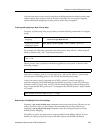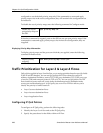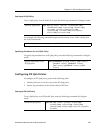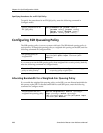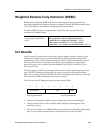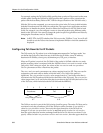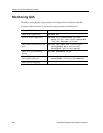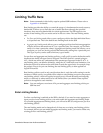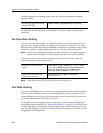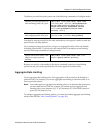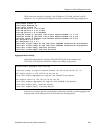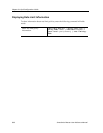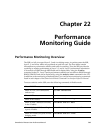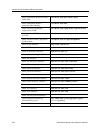
SmartSwitch Router User Reference Manual 303
Chapter 21: QoS Configuration Guide
Limiting Traffic Rate
Note:
Some commands in this facility require updated SSR hardware. Please refer to
Appendix A for details.
Rate limiting provides the ability to control the usage of a fundamental network resource,
bandwidth. It allows you to limit the rate of traffic that flows through the specified
interfaces, thus reserving bandwidth for critical applications. The SSR supports two
modes of rate limiting; only one mode can be in effect at a time. The rate limiting modes
are:
• Per-flow rate limiting mode allows you to configure policies that limit individual flows
to a specified rate. This is the default rate limiting mode on the SSR.
• Aggregate rate limiting mode allows you to configure policies that limit an aggregation
of flows (all flows that match an ACL) to a specified rate. For example, you can limit
traffic to or from a particular subnet. Aggregate rate limiting mode also allows you to
configure port-level rate limiting policies that limit traffic coming into a particular port.
This type of policy can be used to limit any type of traffic.
For per-flow and aggregate rate limiting policies, a traffic profile is used to define the traffic
characteristics before an upper limit is assigned. The traffic profile is created using an
ACL, which can utilize any combination of the parameters supported in the IP ACL. A
rate limiting policy can then be defined by using the ACL and traffic rate limitations. You
define the action to be taken on the traffic that exceeds the upper limit; for example, drop
the packets. Except for port rate limiting, the rate limiting policy is then applied to a
logical IP interface.
Rate limiting policies work in only one direction; that is, only the traffic coming in on the
interface to which a policy is applied will be subject to rate limiting (except for output port
rate limiting policies, which are applied to egress ports). If both incoming and outgoing
traffic to a network or subnet needs to be rate limited, then you should create separate
policies to be applied to each interface.
Note:
You can configure a maximum of 24 port and aggregate rate limiting policies per
SSR line card.
Rate Limiting Modes
Per-flow rate limiting is enabled on the SSR by default. If you need to create aggregate or
input port-level rate limiting policies, you must enable the aggregate rate limiting mode.
If you enable aggregate rate limiting mode, you will not be able to configure new per-flow
rate limiting policies.
The rate limiting mode can be changed only if there are no existing rate limiting policies.
For example, before you can enable aggregate rate limiting mode, you need to delete any
existing per-flow rate limiting policies.



